
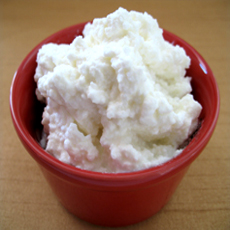
Not all ricotta is created equal. This exquisite cheese is from Mozzarella Fresca, a NIBBLE Top Pick Of The Week. Photo by Melody Lan.
|
STEPHANIE ZONIS focuses on good foods and the people who produce them. Click here to contact her.
|
|
June 2006
Updated May 2015
|
 |
Remarkable Ricotta: Ricotta Cheese
Plus A Recipe To Make Ricotta At Home
My name is Stephanie Zonis, and welcome to Whey to Go! for June, 2006. Every month, we’ll delve into a new cheese-related subject, and I’ll offer a recommendation of a cheese I love.
Overview
Last month, I discussed mozzarella; ricotta seemed a natural extension of the subject, as the two are so often found paired, both fresh (unaged) cow’s milk cheeses used extensively in Italian cooking. But if you use ricotta only as a companion to mozzarella in pasta dishes, you’re missing out on any number of possibilities. There are bread, pancake, and pizza recipes with ricotta, and it makes a wonderful and versatile dessert cheese.
Of course, ricotta cheesecake and cannoli spring to mind immediately in the latter category, but there are many more ricotta-based desserts, and not all are so elaborate. This cheese makes a great topping for good summer fruits, especially berries. Fit a food processor with a steel blade, then process as much ricotta as you need until it’s perfectly smooth, scraping down the container of the food processor once or twice. Thin it with a little milk or plain yogurt, and, if you wish, sweeten the processed cheese slightly with honey. This mixture will even keep for a few days in the fridge, although it will thicken somewhat as it stands. For a different option, ricotta can be baked. And I love warm, freshly-made ricotta as a dessert all by itself, drizzled with honey and sprinkled with cinnamon. If you didn’t know, it’s possible to make ricotta in a home kitchen, and it’s not a terribly complex process (the recipe follows later in this article).
Technically, ricotta isn’t a cheese at all; if anything, it’s a by-product of the cheesemaking process. The name “ricotta” means “recooked” in Italian (from the Latin recoctus). Historically, ricotta has been made from the whey that was left over from the process of making a cooked cheese. What to do with the whey has long been a question in the cheese world; many cheesemakers of long ago simply fed it to their pigs, a practice still continued today. But somewhere along the line, someone discovered that the whey contained proteins and milk solids that would coagulate under high enough heat and with the presence of acid, and ricotta was born. |
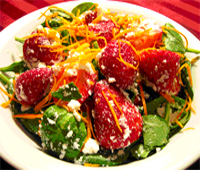
Strawberry, spinach and ricotta salad.
Recipe on MozzarellaFresca.com. |
As with other cheeses, there is disagreement regarding the first historical appearance of ricotta. One cheese website I’ve found describes it as a “traditional, creamery, whey cheese made from cows’ milk”; other sources insist ricotta was first made from the sheep’s or goats’ milk. One thing is certain: ricotta is a venerable food. Early mentions and depictions of the ricotta-making process go as far back as at least the 1100’s. The cheese may be Italian in origin, but it also may have been made first in Greece.
From the above paragraph, you know that ricotta may be made from sheep’s milk, goat’s milk, or cow’s milk, but it has also been produced from water buffalo milk (or, more accurately, the whey of the milk of these animals). In the U.S., it is most often made from cow’s milk and/or whey, which results in a slightly sweeter and moister product, a bit more like cottage cheese. Regardless of the milk or whey used for preparation, ricotta is a fresh cheese and should be kept for only a few days, or it will acidify. |
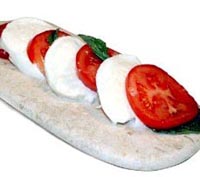
Mozzarella di bufala, a connoisseur’s
delight.
|
If you’d like a whey-based cheese that is a “keeper,” ricotta salata, a dried, saltier, aged sheep’s milk cheese (some refer it ricotta secca, but it is not dried fresh ricotta). Ricotta salata is a firm cheese, ideal for grating and often used in salads or pasta dishes. There’s also ricotta affumicata, an aged cheese that is smoked in the early part of the maturing process. Like ricotta salata, it can be eaten with bread or grated on pasta, gnocchi, and cooked vegetables.
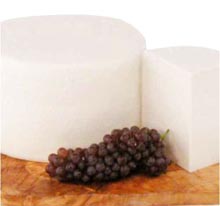 |
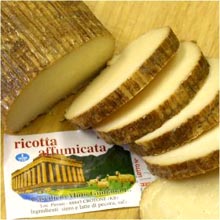 |
|
| Ricotta salata, a pure white, firm, rindless cheese. This one, from Sicily, is made from lightly salted sheep’s milk curd that is pressed and dried, then aged for a minimum of three months. Click here for more information. |
Ricotta Affumicata is made from sheep’s
whey and smoked in the first days of
maturing. Shaped like a round loaf, the rind is dark beige from the smoking, with a white ivory interior. Firm and tender, this cheese, from Calabria, has a slightly smoky, slightly salty flavor. Click here for more information. |
|
Recipe: Make Your Own Ricotta
Since THE NIBBLE’s editorial director recently reviewed the fresh cheeses of Mozzarella Fresca and so highly recommended their ricotta (click here for the review), rather than give a source for mail-order ricotta, I thought I’d provide instructions on how you can make it yourself; the recipe is below.
EDITOR’S NOTE: We have made our own ricotta, mascarpone and mozzarella. It’s a fun experience for cheese-lovers, but we have never gotten close to the quality of what is produced by the top manufacturers. Even when using organic milk, ours is not fresh that day; our kitchen environment does not reach the temperatures of the cheese production rooms that is conducive to great cheesemaking; we don’t have the skill or equipment of the professionals. Plus, this is two or three house of labor and clean-up for something that can be purchased for three dollars. But it’s nice to know that, if we were living in an area of the country where there simply were no fresh Italian cheeses to be had, we could make our own passable cheeses.
There are a great many ricotta recipes online, and some are complicated; they begin with whey and require overnight draining periods, when you’re supposed to suspend the ricotta in a cheesecloth bag over a container. I don’t have a local or reliable source of whey, and I certainly don’t have the patience for an overnight draining period.
Once those recipes were eliminated, and I was willing to “cheat” by starting with milk, I still had decisions to make.
|
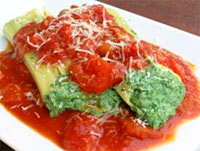
Stuffed manicotti, a classic recipe calling for ricotta. Recipe on MozzarellaFresca.com. |
- For instance, I had to decide upon my acidifying agent. I tried lemon juice, white vinegar, plain yogurt with live cultures, and buttermilk. I even tried some of those agents in combination. But in the end, the lemon juice won. It seemed to have the greatest effect on the milk without an unpleasant taste (some of the other acidifying agents required quantities so great that the resulting ricotta tasted quite acidic), it’s only one ingredient (and a commonly-available one at that), and it works quickly.
- The original for my recipe was given to me by Carmine Chirico, who gave me such good advice last month about mozzarella. I have modified his formula slightly. Carmine is insistent upon the use of non-ultrapasteurized dairy products. I understand his point; whoever heard of milk or heavy cream keeping for 6 to 8 weeks, even under refrigeration? I’m lucky, as I can find both milk and cream that have been simply pasteurized. If you can’t, the recipe will work with ultrapasteurized milk and heavy cream, though you may have to add a trifle more lemon juice. You’ll need a candy thermometer; a heat-resistant rubber spatula (preferably with a broader blade); a heavy-bottomed, four-quart nonreactive pot; cheesecloth; and a colander or large strainer.
Ingredients
- 1/2 gallon whole milk
- 1/2 cup heavy cream (see *Note at the
bottom)
- 3 tablespoons freshly-squeezed, strained
lemon juice
- Salt to taste
Directions
- Rinse a heavy-bottomed, four-quart, nonreactive pot with cold water. Shake out excess water, but do not dry. Off heat, combine milk and heavy cream in pot. Place over medium-low heat.
|
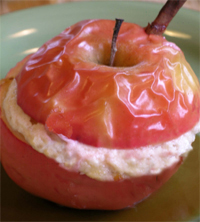
Baked Apple with a ricotta filling.
Recipe on MozzarellaFresca.com. |
- I place my candy thermometer in the pot now, not clipping it to the side but often using it to stir (I have a candy thermometer mounted on a metal frame). The idea is to keep the milk-cream mixture in motion, so that the solids don’t stick to the bottom of the pot and burn. You don’t need to beat the mixture or stir it vigorously, just keep it in motion. I scrape the blade of the heat-resistant rubber spatula over the pot bottom frequently, too. Continue heating and stirring the milk mixture until it reaches 190° to 195°F on the candy thermometer.
- All at once, add the lemon juice. The milk mixture will curdle instantly—I love the “magician’s trick” nature of this! Keep the milk mixture over medium-low heat and stir constantly until the temperature of the mixture returns to 190° to 195°F. Remove from heat and set aside for about 15 minutes.
- Meanwhile, cut a length of cheesecloth wide and long enough to extend a couple of inches beyond the edges of your colander or strainer. (If your cheesecloth is very flimsy, you might want to use two layers; otherwise, one will probably be enough.) Dampen the cheesecloth and line the colander with it; place the lined colander over a pot or bowl to catch the liquid that drains off.
- Once the hot ricotta sits for about 15 minutes, it’s ready to drain. Gradually pour it, liquid as well as curd, into the cheesecloth-lined colander. I have had inconsistent luck with the draining. Occasionally, a batch drains beautifully, without assistance. More often, I have had to “help” by gently stirring the ricotta in the lined colander. The best way to do this, I’ve found, is to gently “scrape” the curd away from the cheesecloth, so the excess liquid can flow out. Don’t let the ricotta drain too much; it stiffens and becomes drier as it chills. I save some of the drained liquid; if I decide I’ve drained too much from the ricotta, I’ll simply stir some of the liquid back in before storing the cheese. You might have to experiment with a batch or two to see how much draining you’ll want; it also depends what you’ll be doing with the ricotta (for eating fresh, I don’t like it too dry, but if you’re using it in a recipe, some require a drier ricotta). And, with some brands of cheesecloth, I can’t get the ricotta to drain much at all. If this happens and you’re facing desperation, simply turn the ricotta (and any liquid) directly into the colander or strainer. You may lose a little cheese this way, but then again, it won’t take hours to drain.
- Gently turn the drained ricotta into a medium, nonreactive bowl, scraping as much as you can off the cheesecloth. Stir in salt to taste. You can consume the ricotta immediately or store it in the refrigerator (seal tightly when cold). Ricotta will keep for up to four or five days in the fridge. This recipe yields about 2 cups, depending on how dry you drain the cheese.
*Note: If you wish, you can eliminate the heavy cream entirely from this recipe. I like the creaminess it lends to the finished product, but the recipe will work using only the half gallon of whole milk; you’ll just end up with a little less ricotta.
Thanks again to Carmine Chirico for his sage advice!
And, here is more inspiration for your fresh ricotta. Recipes are on the Mozzarella Fresca website.
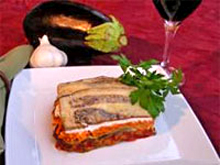 |
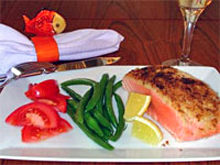 |
| Low-carb eggplant lasagna uses eggplant
instead of pasta to create the layers. |
Ricotta-crusted salmon: ricotta mixed with bread crumbs and parmesan makes a quick and tasty crust. |
Lifestyle Direct, Inc. All rights reserved. Images are the copyright of their respective owners. 
|










